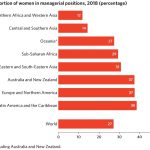Robin Renggli
Imagine you have been working in a consulting firm for six years. You were never late or in default, you can speak several languages and you have a well-founded knowledge of the sector. Finally, you decide that it is now the perfect time to apply for a promotion, and therefore, you hand in your application. It turns out that one of your colleagues gets the job, not because his performance is any better, but unlike you, he is male. In this blog, my goal is to provide you with some numbers and three specific phenomena of gender discrimination at working spaces.
Numbers & Facts
Figure 1 Proportion of women in managerial positions in percentage, SDG report 2019
According to the SDG report of 2019 the number of women in decision making positions has increased in nearly all regions around the globe, except in least developed countries. However, it says further, that women comprised 39% of the workforce in 2018, but hold only 27% of managerial positions. That is a disproportionately high deviation of 12% or nearly one third. The upper graphic provides you with specific numbers for some regions (UN, 2019).
What I find remarkable is the high proportion in Central and South America. Therefore, I took a closer look at some data of 2015 provided by the international labour organisation: Jamaica, Colombia and Saint Lucia have as the top three countries even more than 50% of women in managerial positions. The US is ranked on place 15 [with 42.7%], Germany on place 55 [with 31.1%], Japan on place 96 [with 11.1%]. On the last place is Pakistan with 3% of women in managerial positions (here you can find some nice graphs, that I could not include into this blog due to copyrights: https://visual.ly/community/Infographics/business/percentage-women-managerial-positions, access date: 15/3/2020). What really surprised me was, that there seems to be no direct link between the development state of a country and its percentage of women in managerial positions.
During my research I kept coming across three concepts, through which I am now going to guide you.
Glass elevator
A “glass elevator” or “glass escalator” refers to men in female-dominated jobs, such as nursing or elementary school teaching, benefitting from a set of hidden factors that facilitate their promotions. It can even occur, that men have difficulties to stay in their “not well-paid, female” jobs, even if they would like to do so. In that sense men are effectively “kicked upstairs” (Williams, 1992).
Glass ceiling
Meanwhile, the “glass ceiling” phenomenon is used to describe the invisible obstacles that prevent women from climbing up the professional ladder. Therefore, inequality caused by glass ceiling grows exponentially with the hierarchical structure of the company. These invisible obstacles can be social norms, such as stereotypical thinking, or organisational practices. Glass ceiling was, by the way, the first identified form of gender discrimination in management and it could be one explanation for the trend of lower salary of women compared to men. There is hardly any doubt that this phenomenon exists, however, it must be said that most of the studies on that topic were made in the US (Mecarie & Moldovan, 2012). But, as we have seen earlier, the US have a higher percentage of women in managerial positions than lots of European countries, therefore I do believe that if the glass ceiling phenomenon exists there, it has to be a global issue. Otherwise states like Germany or Japan would be better ranked.
Glass cliff: The illusion of breaking the glass ceiling
All the numbers provided give insights on the quantity of women in leading positions, but what about the quality of these specific jobs? Mecarine and Moldovan refer to the so called “glass cliff” as an illusion of breaking the glass ceiling. Women achieving a leadership are more likely to find themselves on top of a glass cliff, that stands metaphorical for a risky or precarious position. That means that it appears that women are likely to get leading positions in circumstances of general financial downturn or downturn in company performance (Ryan & Haslam, 2005).
Therefore, the simplistic conclusion that women leaders are responsible for poor company performance [as it was made for example in the article “are woman leaders a hindrance?” by Judge in the Times, 2003] should be questioned.
References
Mecarie, F. C., & Moldovan, O. (2012). Gender Discrimination in Management. Theoretical and Empirical Perspectives. Transylvanian Review of Administrative Sciendes, 8.
Ryan, M. K., & Haslam, S. A. (2005). The glass cliff: Evidence that women are over‐represented in precarious leadership positions. British Journal of management, 16(2), 81-90.
UN. (2019). The Sustainable Development Goals Report 2019.
Williams, C. L. (1992). The glass escalator: Hidden advantages for men in the “female” professions. Social problems, 39(3), 253-267.
This post has been written by Robin Renggli
Media Attributions
- Grafik
